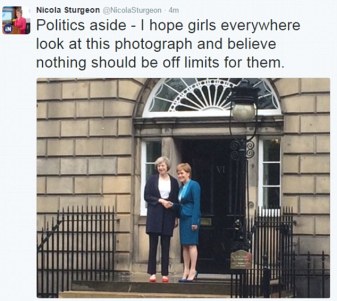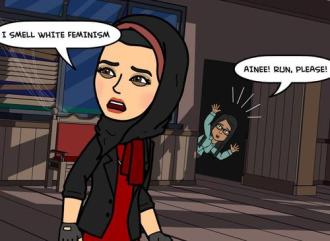Talk given on 30th July 2016 at Living Islam Festival
This conversation has to begin by discussing the way hijabis and niqabis as ‘Visibly Muslim’ women have become central objects of Islamophobic language and action. There is a particularly frustrating white feminist desire to “unveil” and “free” the Muslim woman. Other than the weapons of mass destruction that never materialised, this was a central argument in the lead up to the Iraq war. One only needs to look to Laura Bush’s words to see how apparently “the fight against terrorism is also a fight for the rights and dignity of women.”
This argument is not new and stems from a long running colonial language that suffragettes used to position themselves as superior to their so-called “sisters” in India or on plantations in the US.

This is typified through the suffragette Emmaline Pankhurst stating that she would “rather be a rebel than a slave” when many Black people were both. Such a sentiment was re-stated in promo photos made for the latest in a long line of films on the suffragette movement as the standard for feminist activism.
The Sun journalist, Kevin Mackenzie, drew from this to verbally attack Fatima Manji, a hijabi journalist on Channel 4 – Mackenzie used this colonial language to describe the hijab “as a sign of the slavery of Muslim women by a male-dominated and clearly violent religion.”
This language positions Muslim women as objects and victims incapable of organising and fighting against oppression within our own communities by ourselves. Whilst they continue to use the hijab as a symbol of our lack of integration, we are forced into a defence of our bodies and clothing practices as either empowering and feminist (read, liberal feminist) or oppressive and barbaric (read Muslim).
It is not our voices, nor the reality of our lived experiences that matter – our existence is understood only in terms that have already been pre-defined. And the Muslim women voices that are amplified are the ones that feed into our role as victim or threat (or potentially both).
When Nicola Sturgeon posed with Theresa May and tweeted “Politics aside – I hope girls everywhere look at this photograph and believe nothing should be off limits for them,” I can’t help but think of the girls and women who have been violated and abused through Theresa May’s role as Home Office Secretary, and her belief that migrants could pose a threat to a cohesive nation.

I am reminded of Yarls Wood, a detention centre with numerous reports of sexual abuse, and May’s Home Office’s refusal to release the full information about the extent of the abuse because it would “damage the commercial interests” of those involved in running Yarls Wood. I am reminded of a rape survivor who had been coming to the UK to seek asylum describing her experience at Yarls Wood as “being raped all over again.” I am reminded of the British bombs dropped on Black and Brown people regardless of their gender, and the walls built to prevent them from leaving a situation created by Western governments. And I have to wonder which girls Nicola Sturgeon was thinking about.
This shows the way state policy picks up on different so-called ‘feminist’ ideas on female empowerment whilst ignoring the oppression faced by Women of Colour.

Replacing the figure of a white male with a white woman does not mean justice for all – it just means someone of a different gender becomes responsible for the horrific violence inflicted on People of Colour, no matter whether they are male or female.
This is not limited to power feminism – I am also speaking of the radical/queer/anarcho branches of white feminism that speak of “allyship” with Women of Colour without reflecting on the way these movements benefit from and perpetuate oppression towards racialised bodies. This ends up reducing all experiences to the experiences of “women,” a manoeuvre that has historically silenced the oppression faced by Women of Colour in favour of issues that predominantly affect white women. It also functions to set up the ultimate “baddie” as the patriarch .This is nothing but a false allyship: Women of Colour have seen the way that white supremacy and patriarchy function to maintain oppression. To assume that some form of “allyship” could be formed through one without recognising white feminists’ complicity and active perpetuation of violence against our bodies regarding the other is to keep silencing the experiences of Women of Colour.
This does not mean that I think there is no place for battling sexism within the Muslim community. We need to be honest about the ways in which gendered violence is perpetuated and covered up because of our fear of feeding into this negative and “oppressed” stereotypes of Muslim women. But I look to Black feminism here when thinking about how all of us (regardless of gender or race) can work towards ending gendered violence whilst also fighting against Islamophobia and imperialism.
I’m going to end on a bit of a soppy note because my mom is in the audience, and for me, she is the first person I think of when I reflect on how I came to call myself a Black feminist. It was my mom who taught me how loving and caring for those around you is such a powerful tool. She showed me the importance of these kitchen spaces and living rooms as a place where women shared knowledge, shared experiences, and found strength to support one another. Again and again, she found herself negotiating this incredibly white world and still found a way to be, to love, and to not allow it to take away her humanity. Her kindness, strength and survival is my legacy, and it humbles me to know that she has achieved so much just by existing in this world. On her terms, and not terms that are predefined by Islamophobic and sexist systems.
But her story is not the only one. Like so many of us, my parents came to the West to work for a life for themselves and their children after resources and opportunities were systematically stolen from their lands.

Their survival is our legacy and a source of pride: they were so brave, and we should be too.
We need to remember that a battle against sexism does not need to be done on terms predefined by a feminism that centres the lives and concerns of white women. We deserve to fight against sexism and any form of discrimination, whilst using the tools that have been taught to us by our families and our experiences as Women of Colour. This battle against oppression will not be done through military attacks or perpetuating stereotypes and shaming language directed at our own people. Instead, we use our differences to connect our experiences to one another and to tackle the systems of oppression that affect us all.


Reblogged this on hafsahaneelabashir's Blog and commented:
A spot on article by my amazing activist sister Azeezat Johnson! X
LikeLiked by 1 person